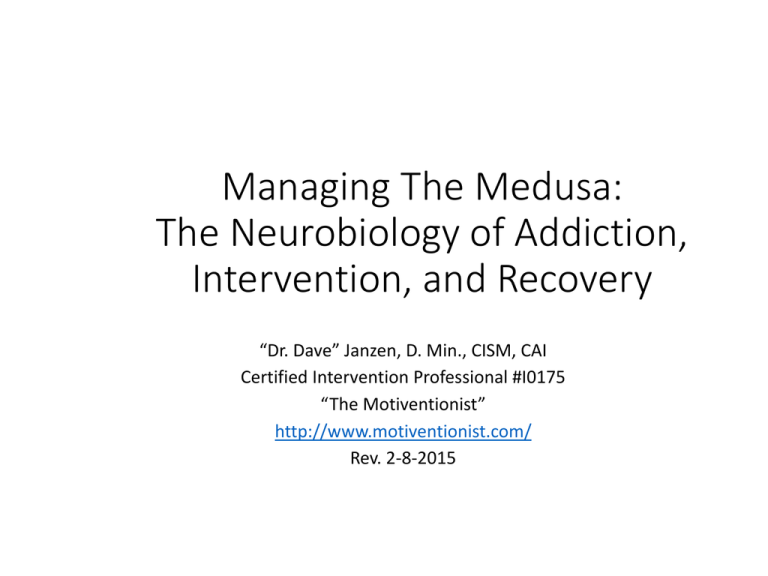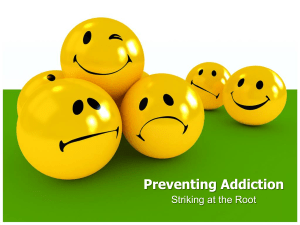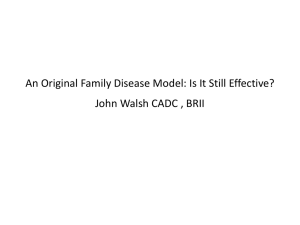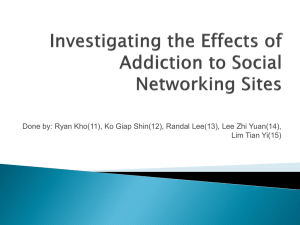
Managing The Medusa:
The Neurobiology of Addiction,
Intervention, and Recovery
“Dr. Dave” Janzen, D. Min., CISM, CAI
Certified Intervention Professional #I0175
“The Motiventionist”
http://www.motiventionist.com/
Rev. 2-8-2015
Objectives
1. Identify the three primary layers of the brain and their essential
functions
2. Explain the basic processes and structures involved in the disease
of addiction
3. Understand how addictive disease interferes with normal brain
functioning
4. Understand how neurobiology informs effective intervention and
promotes recovery
5. Incorporate these fundamental neurobiological concepts into
intervention, treatment, and long-term recovery planning
This is not:
• A graduate/medical school course in neurobiology;
• A thorough review of current in-depth research
• Though I seek constantly to be informed by this research
• A discussion of ASAM, DSM, or ICD criteria
• Necessary for professional assessment and treatment
• Confusing for clients and families
• A discussion for the evolution/creation debate
• Also not training for home brain surgery
This is:
• A broad overview of brain structures and processes
• A presentation of images and metaphors to be used
by mental health professionals and peer specialists:
• For your own understanding
• To inform choices in clinical practice
• To educate clients
• To coach families in supporting recovery
ASAM Definition of Addiction
• Addiction is a primary, chronic disease of brain
reward, motivation, memory and related circuitry.
Dysfunction in these circuits leads to characteristic
biological, psychological, social and spiritual
manifestations. This is reflected in an individual
pathologically pursuing reward and/or relief by
substance use and other behaviors.
ASAM Definition, cont’d.
• Addiction is characterized by inability to
consistently abstain, impairment in behavioral
control, craving, diminished recognition of
significant problems with one’s behaviors and
interpersonal relationships, and a dysfunctional
emotional response. Like other chronic diseases,
addiction often involves cycles of relapse and
remission. Without treatment or engagement in
recovery activities, addiction is progressive and can
result in disability or premature death.
Progression to Addiction, then to Recovery
• The progress of addictive disease moves control of
choices and behaviors
• From the “higher” (or, most recently evolved) cortex
• Down to the more primitive, “reptilian” regions
• Intervention seeks to begin the recovery process
• By engaging supportive relationships
• To activate the cortex
• Recovery seeks to bring healing and regain control
• Back up into the cortex
Medusa -Bernini
The Myth of Medusa
• From Greek Mythology
• A beautiful priestess of Athena
• Tryst with Poseidon, cursed by Athena
• Rings true through the ages because of the power
of reptilian behavior
• Association of reptilian with frightening, deceptive,
and deadly
• Including many major religions
• And some ex-partners
Addiction and Reptilian Behavior
• Most families that have had to deal with the impact
of addiction
• Report “S/he has become a different person.”
• “We want our old ______ back”
• Confirmation that some of their behavior is:
• Reactive
• Hostile
• Defensive
• It’s an opportunity to ask, “Would you like to know
why?”
• And, “Would you like to know what to do about it?”
Addiction is a Process
• Begins with choices (mostly)
• Some stories of nearly instantaneous addiction
• Becomes compulsion
• Chemical addiction and behavioral addiction have
many of the same underlying structures and
processes
• These processes move decision-making control
• From the higher brain
• Into the more primitive, reptilian brain
Intervention and Recovery is a process
• About moving the control for decision-making back
into the higher brain
• While managing the powerful influences of the
more primitive brain
• We do not yet have a “cure”
• We can manage symptoms and promote recovery
It’s all about that Brain
It’s all about the neurons
•Density
•Complexity
•Ratio
•2-3% of body mass
• Uses 15-20% of calories
•Organic network of each neuron with the
whole brain
Two modes of communication
• Along the neuron
• From the nucleus down to the axon terminals
• Electrical impulses signal instructions to release NT
• Between neurons
• Neurochemical
• Neurotransmitters:
• Serotonin, Norepinephrene, Dopamine, glutamate,
GABA, etc.
• Other neuropeptides
The Brain’s 3 Layers
•Upper Layer: Cerebral Cortex
•Mid-Brain/Limbic System:
•Brainstem:
•Survival
•Reactive
•“Reptilian”
•“Snakes on a Brain”
Cerebral Cortex
• Our most-recently-evolved region of the brain
• The most significant difference compared to the brains of other
species on the planet
• Sperm Whale – 17 lbs. of brain, most dedicated to musculoskeletal
management
• Human brain – 3 lbs.
• Human brain has far more neurons, highest ratio of cerebral cortex to
body mass & rest of brain of any species
• The Cortex is dedicated to integrating sensory & reflective
information related to our Social Nature
• Cortex is most like a “social computer”
Relationship to our development as “Human”
• 500,000 years ago, started using tools
• 50,000 years ago, started using fire
• Allowed migration to colder regions
• Cooking food made more calories available
• More calories made larger “calorie hog” brains possible
• Nevertheless, ancestors always near extinction
• Exposure
• Starvation
• Disease
• Competition
The Cortex as “Social Computer”
• Our social nature put us at the top of the food chain
• Massive processing is required for:
• Language
• Tone of voice and facial expression
• Social group cues of:
• Hierarchy, Threat, Nurture
• Social interaction with the environment
• Hunting/gathering
• Security
• Shelter
• Technology – knowledge & skill accumulation/sharing
The Mid-Brain, Limbic System
• Emotional and sensory processing and response
• The primary feeling and reacting centers
• Many separate structures for self and species preservation
• Amygdala – Fear, Rage & reactivity with environmental cues
• Hippocampus – Memory and Spatial interaction; Patterns
• Hypothalamus – Endocrine, Sexual, and Autonomic control
• Temperature regulation
• Arousal and Craving
• Hypothalamus also outputs limbic processes to the rest of the brain
• Found in the earliest mammals and since
The Reptilian Mind
• So-called because it’s as far as reptiles evolved
• Reptiles don’t nurture their young
• Reptiles are purely reactive creatures
• Includes the Brainstem and Cerebellum (coordination)
The Reward Pathway
• Natural Rewards
• Food
• Water
• Sex
• Nurture
• (Air)
Pleasure: One Mechanism
• All Human pleasure has one mechanism
• The release of Dopamine by neurons in the Nucleus
Accumbens (and the VTA)
• Intensity is determined by
• The speed of Dopamine release
• The number of cells releasing, and their amount released
• The time Dopamine spends on receptors and in the Neural Synapse
• With repeated use, Glutamate (a neurotransmitter
associated with learning) is released
• This generates an association (behavioral memory); so that
experience becomes motivation, leading to intense craving
• Permanent association with natural rewards
Some Ways the Addiction Process Begins
•Peer use/pressure & experimentation
• Earlier starts increase likelihood of addiction
• Desire to “fit in,” to feel “normal”
•Co-occurring disorders (self-medication)
• Some CooD in majority of instances
• Depression/Bi-Polar, ADHD, Anxiety, Personality
Disorders, PTSD
•Family/Marital Trauma and/or Conflict
Stages of Progression,
Abstinence to Addiction
• Abstinence
• Use
• Abuse
• Tolerance
• Dependence
• Addiction
Dependence
• Brain only functions “normally” in the presence of the drug/behavior
• Repeated use overworks & damages neurotransmitter systems
• Without drug/behavior, significant physiologic withdrawal symptoms
occur
• Continued use becomes is about avoiding withdrawal symptoms
• By this point, drug/behavior has made a permanent connection with
the reward pathway & the primitive (reptilian) brain
• Early abstinence is experienced as life-threatening by the reptilian
mind
Addiction
• Dependence is the physiological condition
• Addiction is the compulsive response to dependence
• Loss of control in limiting use
• Example: returning Vietnam Veterans
• These distinctions are not part of the ICD or DSM clinical
diagnosis or treatment criteria, “Substance Use Disorder”
dimensions
• This is to help clients/families make their own choices in
response to presenting problems
E.g., “Why is (my kid) acting that way?
• Because addiction “lives” in the “reptilian mind”
• Or, as I like to call it,
• “Snakes on a Brain,”
• Results in reptilian behavior
• Quitting feels like dying in the primitive brain
• Defensiveness, denial, reactivity
• Are not about you
• It’s about the disease defending itself
• Like a rattlesnake
How does this inform choices? Families can:
• Think strategically for outcomes
• Instead of tussling over who’s right/wrong
• Collaborate to manage reactivity
• Instead of reacting
• Choose to respond
• Set common family goals for well-being
• Instead of focusing on the AI
• As a “problem to be fixed”
• Don’t take the AI’s actions personally
• It’s not about you!
Intervention & Treatment
•When an addicted individual can’t
or won’t stop
•Intervention may be necessary
•Why professionals?
•Different Models
•Part of the Continuum of Care
What Is An Intervention?
• Marshalling resources to manage resistance
• Leveraging significant relationships
• Overwhelming the Addicted Individual with love
• Crucial moment/opportunity
• Not just for detox/rehab
• Recovery is for everyone involved
• Continuum of care for at least a year
• For the Addicted Individual
• For the family & significant others
Job #1: Managing Reactivity
•Because dependence/withdrawal lives in the
“reptilian mind”
• “Snakes on a Brain”
• Reactivity is a defense mechanism
•Reactivity is contagious!
•Cats metaphor
•Expect reactivity to emerge
•Prepare to manage reactivity
The Intervention Team
• Highly reactive family members may be asked
• To not participate
• To only write a letter
• Pre-intervention orientation & coaching
• Educate about the brain disease of addiction
• Focus on the problem of reactivity
• Get confirmation from each member of the team that
they:
• Understand the issue
• Commit to remain calm
Guidelines for all Intervention meetings
•Review group goals & ground rules
•Monitor group for signs of reactivity
• Posture, Tone of voice, Facial expressions
• Watch out for Hi-jackers
•Monitor self!
•Take breaks
•Keep the tone respectful and loving
•Focus on building value in relationships
Family Follow-up
• Homeostasis
• Coaching to encourage, not enable
• Try to identify “family rules,” patterns
• Job #1- Identify & manage reactivity
• Transactional Analysis training
•P – A – C
• Parent/Adult/Child communication dynamic
• Move from “You…” to “I…” messages
The Recovery Message
•Involve entire Intervention Team in building
the message
• Use the Rec. Msg. to keep team on track
• Avoid Red Herrings
• Helpful in preventing a hi-jacking of the process
•I use the SAMHSA recovery definition as a
starting place
• Works for Psychiatric Interventions (Bi-polar, psychotic
pts.)
• Works for everyone involved
Recovery Definition (SAMHSA)
•"A process of change through
which individuals improve their
health and wellness, live a selfdirected life, and strive to reach
their full potential."
Keep Mind Management Moving UP
• Addiction is a process
• Involves the whole brain
• “Resides” (is most active in) the more primitive brain
• Progression of the disease is “down”
• From choice to compulsion
• Behavioral control moves from Prefrontal Cortex
• To compulsive drives of the reptilian/limbic
• Choice surrenders to over-riding demands of the
reptilian mind
Movin’ on up…
• Recovery is also a process
• Progression of recovery is “up”
• Returning behavioral control to Cortex
• Learning to manage emotions
• Respond rather than react
• Peer groups (AA, NA, Smart Recovery, etc.)
• Healthy relationships re-engage Cortex
• Activate the “Social Computer”
This is why:
• Confrontation seldom provides lasting benefits
• Also why the recovery groups work
• Few stories of recovery in isolation
• Sponsors, meetings, recovery friends
• Healthier family functioning is not optional
• Motivational Interviewing works
• Spirituality helps
• Looking beyond self is “higher brain” activity
Parable of the Two Wolves
• Young Brave in distress about inner conflict
• Counsel of a tribal Elder
• “You have two wolves within you, fighting for your
soul;
• “One is good and one is evil.”
• “Which wolf will win?”
• “Whichever one you feed!”
Links:
• “Dr. Dave’s” website:
• http://www.motiventionist.com/
• Managing the Medusa webinar:
• http://www.naadac.org/managingthemedusa
• Images, public domain:
• http://tayloredge.com/reference/Science/
• Drugs disrupt neurotransmission course
• http://science.education.nih.gov/supplements/nih2/addiction/guide/lesson3
-1.htm
• Harvard's guide on how addiction hijacks the brain
• http://www.helpguide.org/harvard/how-addiction-hijacks-the-brain.htm
• NIH's Drugs, Brains, and Behavior: The Science of Addiction:
• http://www.drugabuse.gov/publications/drugs-brains-behavior-scienceaddiction/drugs-brain
Links, cont’d:
• NIH's curriculum for High School students, "The Brain: Understanding
Neurobiology Through Addiction"
• http://science.education.nih.gov/supplements/nih2/addiction/default.htm
• NIDA main web site:
• http://www.drugabuse.gov/
• McGill University, "The Brain from Top to Bottom":
• http://thebrain.mcgill.ca/flash/d/d_05/d_05_cr/d_05_cr_her/d_05_cr_her.h
tml
• Dartmouth's Neuroscience on-line course, ch.9 on the Limbic System
• http://www.dartmouth.edu/~rswenson/NeuroSci/chapter_9.html
• Transactional Analysis, original source information:
• http://www.ericberne.com/transactional-analysis/








